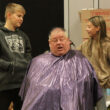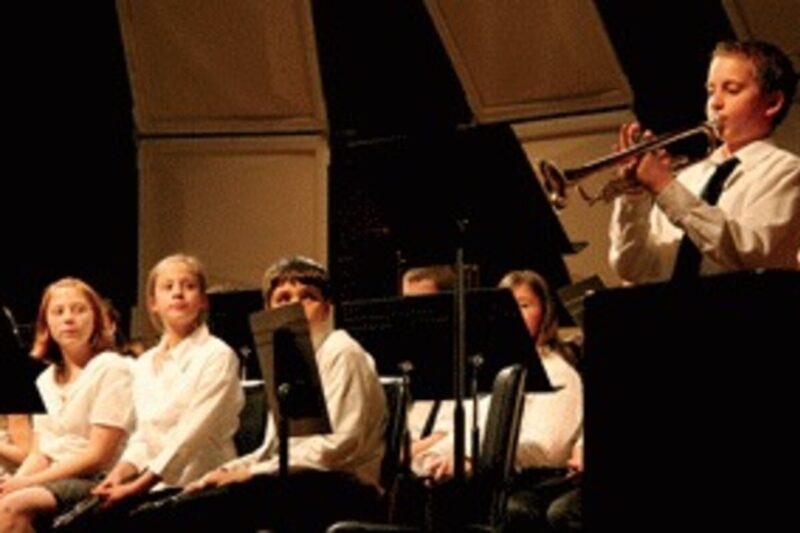Sean C. Morgan
Of The New Era
School District 55 has a new elementary physical education program, but it’s also getting a music program rolling – something that Supt. Larry Horton anticipated working on, not starting, this year.
Earlier this year, the district failed to qualify for an Oregon Symphony grant that would have provided $350,000 worth of in-kind services to the district from symphony members who would visit and provide direct instruction to students, 75 percent of it to the elementary level.
Retired district band teacher Ken Collins, who helped prepare the grant application, said the district fell short of qualifying because it has no sustainable elementary music program.
That may change if the district’s music staff and Horton get their way, even if there isn’t much money for it.
The district needs elementary music teachers to back up what the students will get from the symphony grant, Collins said.
“I never, never give up,” he said, vowing to go after the grant again when the next opportunity comes up in two years, after the district can get some new music programs into place.
“I think what the school district is coming up with is an excellent idea,” Collins said.
The district has had some programs available to elementary students.
“Even as we speak, we currently have band and choir in grades seven through 12, with beginning band in the sixth grade,” Horton said. The district also has teachers in the elementary schools with their own skills, who teach music informally, such as Dan Swanson at Crawfordsville.
Swanson set out to learn music for himself so he could teach his students. Now he teaches them to play the recorder. Former Hawthorne Principal Gloria Mittleman directed an elementary choir when she worked for the district.
“It’s been many years since we had a formal elementary program,” Horton said. He and the School Board talked about bringing PE and music back at the elementary level last year, and the district was able to get grants from the state driving it to focus on PE.
“This year, one of my three goals was to bring back elementary music in some form,” Horton said. “Research shows over and over again the advantage of music, even in academics. My quest is to figure out how to do that with a small budget.”
The answers started coming together over the summer.
Oak Heights’ Stealth Music Program
The district was having difficulty finding a PE teacher for Oak Heights, Horton said, so the district hired Tegan Johnson as a half-time “movement education” teacher.
Her husband is band teacher Pat Johnson, who teaches band for the sixth through 12th grade.
She knows music and rhythm well, although she is a vocalist, Horton said. She provides the PE opportunities for Oak Heights through music. She teaches basic music concepts using a variety of physical games and dance.
Tegan Johnson’s class gives students a half hour twice a week using music to move and much more.
“I am primarily a singer, so we work a lot on their voices,” she said, adding that she plans to introduce musical instruments as well, teaching students how to read notes and rhythm. The basic theory will get them ready for junior high and the high school.
Her activities nearly always involve approaches using kinetic, aural and creative teaching and learning styles, she said.
Music theater is among her specialties, she said, so she’ll be involved in the production of the school’s annual operetta this year and plans to take over next year after teacher Kathy Ives retires. Ives has directed the fifth and sixth grades in the operetta for about 30 years.
High School Students to Mentor, Teach Elementary Students
More than her role as a sort of “stealth” music teacher, the district music staff is turning to Tegan Johnson to run a mentorship program using high school music students to share their knowledge with elementary students.
“At the end of last year, I talked to choir director Matthew Clark and band director Pat Johnson, and we started brainstorming ideas,” Horton said. “How do you fund a program that has no money?
“(Pat Johnson) was wanting to grow his music program, and I wanted to grow the elementary program.”
“It’s like the wrestling program,” Horton said. The high school wrestling program starts children wrestling at a young age to develop skill and interest in the sport, feeding the program with talented athletes. An elementary program can do the same.
Now in his fourth year as band director, Pat Johnson said, he started with 18 in his high school band program. That has gone up to 40 this year, including 21 freshmen who were members of his sixth-grade band. He anticipates the program to grow to between 55 and 60 in the next few years.
Johnson told Horton the district needs an elementary music program, he said. That would not only help make students well-rounded, but it also improves academic performance.
Based on a wide variety of research, Johnson is convinced it will have a direct impact on improving district test scores, he said. Music is important on its own, but it also addresses the state and district’s bigger goal of improving those test scores.
Research shows that music helps build children’s synaptic networks, improving their overall cognitive abilities, he said.
While researchers suspect a link between music and skills like reading and are just now learning how music affects the brain, said Dr. Phyllis Paul, who runs the elementary music education program at the University of Oregon, a music education is even more important for its own sake.
“Music is everywhere, a part of everybody’s life,” Paul said. Not being educated in it is like not being educated in science or reading and all of the losses that would entail.
Education offers students with an affinity for specific subjects to grow and learn in them, eventually moving into careers relying on those subjects.
“Without the opportunity to explore that, we are shutting off lots of students who don’t get to know what it’s like,” Paul said.
“Larry is saying, ‘I agree with you. What do we do?'” Johnson said. That’s when they put their heads together to figure it out.
Johnson talked to his wife, who also is a University of Oregon instructor working for Paul, and they all started communicating by e-mail over the summer and started applying for grants, Horton said. An idea started taking shape.
“We have a cadet teacher program at the high school, with kids working with elementary teachers already,” Horton said. Students interested in teaching careers can participate in the program.
“We do this with general elementary,” he said. “Why not look at our music students?”
Part of Tegan Johnson’s job at the UO is to work with beginning music instructors. That’s where the district will turn to her. She will work with the high school students and then send them out to work with elementary students on basic note instruction, beginning vocals, introduction to music instruments, folk dancing and more.
The district will run the pilot program at Hawthorne this year, Horton said. Four high school students will receive training with Tegan Johnson and go to work at Hawthorne for high school credits.
So far, high school senior Katie Kinney is the only student who is signed up for the program. Justin Wales is attempting to schedule the time, and another student is planning on joining the program later in the year.
“I’m going down there (to Hawthorne) as a mentor, and I’m going to be teaching music,” Kinney said. “I want to be a band teacher. I would die to be a band teacher.”
And she is looking forward to getting a taste of it, she said. “I love music. Everywhere I go, it’s about music.”
Starting music education earlier will make learning and teaching it easier, she said. Right now, Pat Johnson starts working with students in the sixth grade. He must start from scratch, and it makes it harder.
“Plus, it’s a lot of fun for them,” Kinney said.
The students will take workshops with Tegan Johnson for two or three weeks, Pat Johnson said. She will develop the lesson plans that the high school students will use four days a week, and they will spend a fifth day continuing their training with Tegan Johnson, helping her with her classes and seeing what she does.
“I’m just going to teach them a lot of what I do in my classroom,” Tegan Johnson said. They will facilitate a music experience for the elementary students rather than straightforward teaching or tutoring.
She also will spend time observing them in action in Hawthorne’s classrooms.
On the final week of each trimester, the high school students will develop a compilation of what they’ve done throughout the term, write a reflection paper and then run through an evaluation process, Pat Johnson said.
When this program proves it can provide tangible results, Pat Johnson hopes it will lead to a more formal elementary music program.
Down the Road
On top of these developments, the UO music program has responded to e-mails from Horton and voiced interest in helping promote an elementary program in Sweet Home, Horton said.
Starting immediately, Paul assigned a student teacher to help Tegan Johnson at Oak Heights.
“I told him (Horton) I’m just so admiring of his decision to bring this back into schools,” Paul said. “We’re moving forward with whatever he needs, ready to help.”
“I think it’s just really going to put music out there as a strong force,” Tegan Johnson said. “Our vision is to really make the community aware of musical opportunities” and give something to students who are not into athletics and other activities but rather more into music, dance and drama.
With everything in place, the Oregon Symphony grant could be winnable, and Collins hopes to win the grant for Sweet Home during its next phase, two years from now, providing even more opportunity to improve culture and music in Sweet Home.
“It’s just really encouraging,” Pat Johnson said of the district’s efforts in music, as well as the fact the district has metal, wood and auto shops. “I’m very proud of this school district. If you compare other districts, we offer more than other districts our size or bigger districts. It’s amazing what we’ve been able to keep. We should be very, very thankful, and I very much am.
“I want this to be something they (students) can take with them for the rest of their lives. I think it’s innovative. It’s out-of-the-box thinking. I think it’s a good place to start, and I think it’s a great launching point to something more in the future.”





